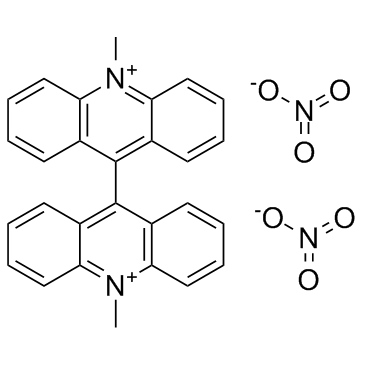2315-97-1
| Name | 10-methyl-9-(10-methylacridin-10-ium-9-yl)acridin-10-ium,dinitrate |
|---|---|
| Synonyms |
Lucigenin nitrate
Bis(N-methylacridinium) Nitrate 10,10'-Dimethyl-9,9'-biacridinium dinitrate N,N`-dimethyl-9,9`-biacridinium dinitrate EINECS 219-023-4 10,10'-Dimethyl-9,9'-biacridinium nitrate Lucigenin Dinitrate de 10,10'-diméthyl-9,9'-biacridinium N,N'-Dimethyl-9,9'-biacridinium dinitrate MFCD00011925 9,9'-Bis(N-methylacridinium nitrate) 10,10'-Dimethyl-9,9'-biacridiniumdinitrat N,N'-Dimethyl-9,9'-biacridinium dinitratein bis-n-methylacridinium nitrate N,N'-Dimethyl-9,9'-bisacridinium nitrate |
| Description | Lucigenin(L-6868; NSC-151912) is a chemiluminescent probe used to indicate the presence of endogenously generated superoxide anion radicals in cells.Upon single-electron reduction of Lucigenin by a radical species the subsequent form of Lucigenin presents an amplified chemiluminescence which is measurable and can be correlated to the respective amount of reactive radical species present in the system. This approach can be used to probe the natural generation of these species as well as the natural functioning of superoxide dismutase and other enzymes responsible for scavenging radicals. In addition to indicating the presence of radicals in cells, Lucigenin shows interaction with redox-active oxidoreductase enzymes. Lucigenin is shown to mediate the reduction of cytochrome C by xanthine oxidase and to increase the rate of NADPH oxidation. These observations indicate that use of Lucigenin for superoxide analysis is precluded in the presence of high levels of NAD(P)H-oxidoreductases. |
|---|---|
| Related Catalog | |
| References |
| Melting Point | 250ºC |
|---|---|
| Molecular Formula | C28H22N4O6 |
| Molecular Weight | 510.497 |
| Exact Mass | 510.153931 |
| PSA | 145.52000 |
| LogP | 6.18360 |
| Appearance | Yellow powder with orange to brown cast |
| Water Solubility | acetic acid: soluble10mg/mL |
| Personal Protective Equipment | Eyeshields;Gloves;type N95 (US);type P1 (EN143) respirator filter |
|---|---|
| Hazard Codes | Xn |
| Safety Phrases | 24/25 |
| RIDADR | 1479 |
| WGK Germany | 3 |
| Packaging Group | III |
